Thanks to everyone who submitted a review for the February 2017 Crimes of the Century challenge to review a book or film from 1943.
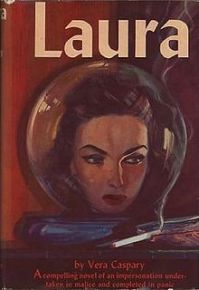
Tracy at Bitter Tea and Mystery celebrated five years of blogging this month, and celebrated by sharing her review of Laura by Vera Caspary:
I had avoided this novel for years. Although I had never seen the movie based on the book, I thought I knew the story, and assumed the story was spoiled for me. That was a mistake; even if I did know one or two main points of the story, there was much there to surprise me and I loved the way the story was told. Laura is a wonderful read and not to be missed.
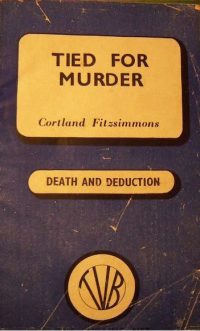 Jason Half meanwhile read the wonderfully named Cortland Fitzsimmons’ Tied for Murder in which…
Jason Half meanwhile read the wonderfully named Cortland Fitzsimmons’ Tied for Murder in which…
 Neer at A Hot Cup of Pleasure looked at Mouse in the Mountain by Norbert Davis:
Neer at A Hot Cup of Pleasure looked at Mouse in the Mountain by Norbert Davis:
The book was a breezy and humorous read but what struck me the most was how Davis satirized his own country and its denizens. Considering that the book was published in 1943 and the USA had become involved in the second world war, it would have been understandable even if the book had been a little jingoistic. But Davis also has a great time introducing humour at the expense of his fellow country-men and women.
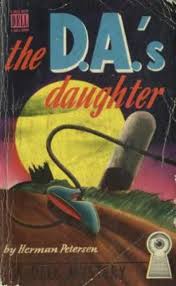 John at Pretty Sinister Books brought us Herman Petersen’s The D.A.’s Daughter.
John at Pretty Sinister Books brought us Herman Petersen’s The D.A.’s Daughter.
This is a pleasant enough detective novel with an amiable hero and some well drawn characters. But it’s also an unusually subversive novel. Hank is probably about 19 years old (he’s about to enter his first year of college) and yet he has an oddly intimate friendship with the 30-something Mrs. Andrews. They first meet at the lake that borders Mrs. Andrews’ now deceased husband’s property. She spends a lot of time sunbathing on the lakefront dock where Hank likes to swim.
 Bernadette at Reactions to Reading listened in to Patricia Wentworth’s The Chinese Shawl, which
Bernadette at Reactions to Reading listened in to Patricia Wentworth’s The Chinese Shawl, which
…started off with an explosion of names and relationships that I had to listen to four times before feeling like I could move into the actual story. I was reminded of the series of team building and leadership ‘experiences’ I was required to attend in the 90’s which always began with a room of 20-30 people telling each other their name and a ‘fun fact’ about themselves and us all then wasting time learning the favourite sock colour of people we would never meet again. I know everyone in a story has to be introduced but here there are thirteen characters shoehorned into the first 5 minutes of the audio book and all but one has at least one important familial connection that has to be remembered. We haven’t even gotten to the country house party at which Significant Events take place yet and I’m already bored keeping track of who’s who (and who’s related to who).
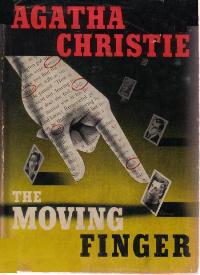 Kerrie at Mysteries in Paradise chose Agatha Christie’s The Moving Finger:
Kerrie at Mysteries in Paradise chose Agatha Christie’s The Moving Finger:
While this is labelled as a “Miss Marple” she really plays a role only in the last quarter of the book. I wondered in my earlier reading about why she appeared so late and I’m almost convinced that Agatha Christie had originally meant this to be a stand-alone. However by the middle of the book, there are too many red herrings, too many possible murderers and the police and the amateur sleuth Jerry Burton are in desperate need of an independent point of view. So Jane Marple to the rescue!
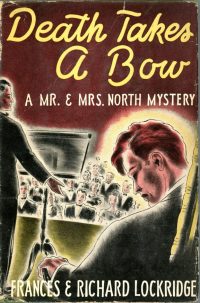
Bev at My Reader’s Block picked up Death Takes a Bow by Frances & Richard Lockridge, a great escape read, and
…if you’re looking for evidence of 1943… there are several references to the war. Everything from mentioning Jerry’s service in “the other war” and the fact that they wouldn’t take him this time “because of his eyes” to the nieces’ penchant for picking up sailors and marines on leave. But never army men. As the book ends:
Beth and Margie both looked radiant as they came in. They both had sailors.
“Those girls,” Pam said, “are unfair to the army. They ought to be–they ought to be picketed.”
 Kate at crossexaminingcrime started with John Stephen Strange’s Look Your Last:
Kate at crossexaminingcrime started with John Stephen Strange’s Look Your Last:
I think this is a book which could be interesting for those who want to look at how the war, Nazis and Communism were being interpreted during WW2 in America, as this is a novel which definitely engages with the times it was being produced in, capturing how people may have felt at the time and also includes real life events such as Rudolf Hess’s flight to Scotland. But as a story which is supposed to entertain it does not do so well. The book is eventful in the episodic way thrillers and espionage mysteries so often are, but unfortunately the political themes deadened the drama of the narrative, particularly in the final furlong of the book.
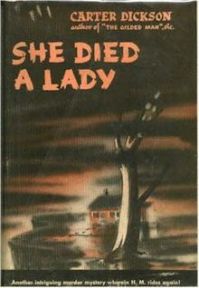 New player Dan at The Reader is Warned chose Carter Dickson’s She Died a Lady,
New player Dan at The Reader is Warned chose Carter Dickson’s She Died a Lady,
There was also some interesting gender reflections when Rita Wainwright is maliciously called a ‘theatrical’ woman by certain characters and therefore not taken seriously, her name being dragged through the mud. This idea becomes subverted as the narrative goes on, and people are shown up for judging a book by its cover. Speaking of which the title is really brilliant, and when revealed in the book it’s a real shocker, relating to these ‘theatrical’ reflections and subversions.
Jose Ignacio also brought us She Died a Lady:
The action unfolds in England during the summer of 1940, shortly after the first air raids to the United Kingdom by Nazi Germany. Plot wise, it revolves around establishing whether the death of two lovers was the result of a suicide pact by mutual agreement or, as some evidences may suggest, both were murdered. Besides, although the facts take place in the open air, we can certainly describe this story as a locked-room mystery or, as I rather prefer to call it, an impossible murder.
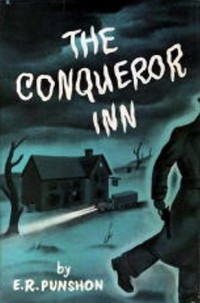
Over to A Crime is Afoot for E. R. Punshon’s The Conqueror Inn.
I’m very pleased to have had the chance to read The Conqueror Inn, a really captivating book in my view that reflects very well the atmosphere and the spirit at the English countryside during the Second World War. The storyline is rather complex but is very nicely structured and, at the end, all the pieces of the puzzle fit perfectly well. The solution to the mystery is stylish and provides an appropriate explanation to all the unknowns posed. Besides, Punshon writes in a style that, in my view, is both elegant and convincing. All in all an enjoyable enigma.
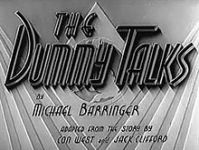 John at Noirish went to the movies. A philandering ventriloquist is murdered in the music hall! Did the dummy do it? Jack Warner stars in The Dummy Talks (1943).
John at Noirish went to the movies. A philandering ventriloquist is murdered in the music hall! Did the dummy do it? Jack Warner stars in The Dummy Talks (1943).
A wartime morale-booster set inside a London variety house/music hall (about the same as a US burlesque theater, but without the, er, disrobing) and relying heavily on the BBC radio popularity of three of its major cast: Jack Warner, Claude Hulbert and Beryl Orde. The movie presents itself as a murder mystery with the added elements of some flippant humor and quite a lot of stage presentations. Despite some genuinely clever moments, it seems today—although fans of music hall might disagree—a tad leaden in places.
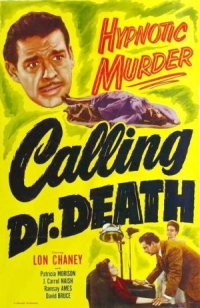 Brad at ahsweetmystery watched the first Inner Sanctum mystery, Calling Dr. Death!
Brad at ahsweetmystery watched the first Inner Sanctum mystery, Calling Dr. Death!
For those of you who don’t know much about old time radio, Inner Sanctum would be a cross between The Twilight Zone and Suspense. The stories were usually twisted tales of crime inspired by a series of novels published under the “Inner Sanctum” imprint. They tended to focus on a character who had either committed a murder or thought that they had committed a murder. They tales were creepy but definitely employed a dose of macabre humor. At any rate, Universal thought that the idea would be great for a series of films, and they signed on Chaney to star in six of them. Each film began the same way, with an introduction (see above) delivered by a disembodied head in a crystal ball. In each film Chaney would play a different character, yet there was a distinctly similar tone to all of them, minus the humor of the radio series. Despite this, and the low-budget look and feel to them, it all amounts to a half-dozen tidy thrillers with much to enjoy.
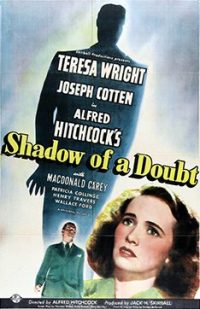 Brad also reviewed Hitchcock’s 1943 masterpiece, Shadow of a Doubt:
Brad also reviewed Hitchcock’s 1943 masterpiece, Shadow of a Doubt:
…the first Hitchcock film to feel like an American original. While it contains many of the ideas he had explored in his earlier work, it is markedly different from those films about an innocent man on the run for a crime he didn’t commit. It is set in a typical U.S. small town (Santa Rosa, California) and focuses on a typical, mid-century nuclear family: father, mother, three children, friendly neighbors who drop by, church on Sunday, the whole picture of normalcy. Hitchcock wanted the town to reflect that illusion of the ideal life, and he turned to playwright Thornton Wilder, whose 1938 depiction of this sort of place, the play Our Town, had won the Pulitzer Prize, to craft the adaptation of the original story. The two men visited Santa Rosa together and interviewed many townspeople to gather local color and give the film the realism Hitchcock desired.
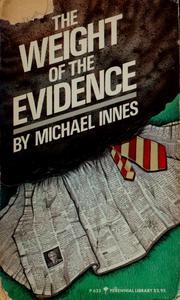 RogerBW read Michael Innes’ The Weight Of The Evidence, the ninth Appleby mystery, and found the Inspector a little unbearable:
RogerBW read Michael Innes’ The Weight Of The Evidence, the ninth Appleby mystery, and found the Inspector a little unbearable:
Appleby observes, and makes notes, but mostly thinks hatefully about all the people he’s meeting. He’ll happily accept their hospitality but soon writes them off as “an unpleasant fellow” or an “awful woman”; the book is in tight third-person perspective so we get most of his thoughts, but at the same time his important deductions are omitted. There’s no sense of progress through the book: there’s just more and more description of increasing numbers of eccentric people (is everyone in this redbrick university town an outright nutter?), the occasional supposition, and a sudden resolution relying on something that has barely been mentioned.
The Puzzle Doctor brought us Reverse The Charges by Brian Flynn, and a suggestion for a drink to try this weekend (if you can wait that long).
One of the fun things of #1943book is seeing how the crime authors of the time dealt with the war. John Rhode/Miles Burton used the fact to various extents in his plotting, Helen McCloy wrote a spy-thriller-mystery and Flynn… just ignores it. There’s no mention of it at all. But what hints of the time are there? Well, we have the word of the month which is “vaticination” – another word for prediction. We have a fish and chip shop being referred to as a “fried fish shop”. Drinks of the time included that popular cocktail a “Clover Club” – gin, lemon juice, raspberry syrup, and an egg white – yumsk! – and sherry came in varieties such as “brown”.
The Puzzle Doctor was also in for 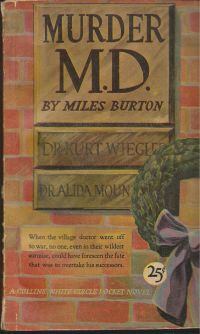 Murder, M.D.:
Murder, M.D.:
1943, in the village of Exton Forcett, all is not well. The village doctor has been called off to war and his locum, Dr Wiegler, has not endeared himself to the community with his bedside manner. Not only is he brusque and rude, especially compared to the man he has replaced, Dr Cecil, but he has a habit of sticking his nose into village business. He seems to have a clear sense of right and wrong and is determined to do something about the things that he has issues with in – until someone decides to murder him.
 And more wartime Rhode in Men Die At Cypress Lodge:
And more wartime Rhode in Men Die At Cypress Lodge:
The wartime setting is used to full advantage. Waghorn is undercover, investigating who is leaking secrets to the enemy, and Superintendent Haslet has been called out of retirement while the younger men have gone to fight. Hemsby’s “suicide” was easily accepted as such as it occurred on the eve of war being declared so people had other priorities… Waghorn smokes a cigarette to “stimulate his mental processes”, two ladies run away from a dead body “incontinently” and there were butchers who specialised only in pork.
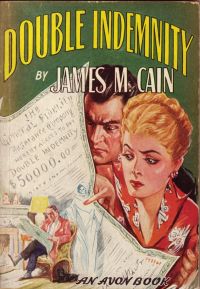 Sergio at Tipping My Fedora went hardboiled with James M. Cain’s Double Indemnity, setting it up as a pace-setting noir:
Sergio at Tipping My Fedora went hardboiled with James M. Cain’s Double Indemnity, setting it up as a pace-setting noir:
It is possible that the public conception of Noir owes more to the success of this book than any other. On the face of it, author James M. Cain just rewrote The Postman Always Rings Twice, telling a similar story of a wife and lover bumping off her husband, finishing up with a volume that is even shorter (just under 30,000 words). But this tart serial from the Depression era ultimately tapped in to the sour mood engendered by the war when collected in a book and in its scheming protagonist created one of the first true Femme Fatales of the genre.
Sergio also found a dark tale from this side of the pond, Graham Greene’s Ministry of Fear starts with Arthur Rowe winning a cake at a village fete.
This book has a dark and dreamlike atmosphere, beginning from the opening sequence where a nostalgic return to the simple entertainments of childhood of a summer afternoon – a coconut shire, a fortune-teller, etc. – slowly but surely turn sinister. But then Rowe is a man haunted by his past. It turns out that he served a short sentence in prison for assisting in the mercy killing of his wife. And now he is being hounded by manifestations of his ongoing guilt in the shape of Nazi fifth-columnists who want what was hidden in a cake that was handed over in error when he was mistaken for a spy.
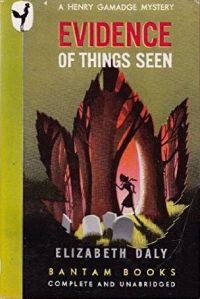 Kate at crossexaminingcrime moved on to Elizabeth Daly’s Evidence of Things Seen.
Kate at crossexaminingcrime moved on to Elizabeth Daly’s Evidence of Things Seen.
Clara is staying at a rural isolated cottage, awaiting her husband [sleuth Henry Gamadge] and some friends who are meant to join her for a holiday. We know that her husband has been sent off on mysterious war work. With only her and a maid in the house this book does begin with a rather HIBK atmosphere, especially with both of their overactive imaginations. For over a week she and her maid have had sightings of a mysterious woman, who seems to be watching them, but never comes close enough to the cottage to be identifiable and Clara gives herself a greater shock when she thinks she has found the mysterious woman’s clothes in the attic; the door of which keeps opening. The narrative sums up the mental state of the women well when it asks the question: ‘Was she getting sunbonnets on the brain?’
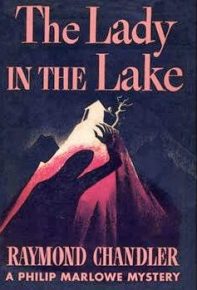 And finally, I pitched in with Raymond Chandler’s The Lady in the Lake, the fourth of six books starring world-weary and constitutionally difficult Los Angeles PI Philip Marlowe.
And finally, I pitched in with Raymond Chandler’s The Lady in the Lake, the fourth of six books starring world-weary and constitutionally difficult Los Angeles PI Philip Marlowe.
Marlowe’s world shows signs of the War in Europe, from rubber rationing to policemen losing interest in their jobs because they are going into the Army in a few weeks.
Thanks to everyone who played, especially the newbies – great to have you – and on to 1937.




Yay I got a quote in the title!
LikeLiked by 4 people
The two other 1943 movies I covered during the month were The Black Raven (1943) and the really quite splendid Paris After Dark (1943), with George Sanders, Brenda Marshall and Philip Dorn.
LikeLiked by 1 person
Just to say, you missed my review of Helen McCloy’s The Goblin Market https://classicmystery.wordpress.com/2017/02/21/the-goblin-market-by-helen-mccloy/
LikeLike
Cheers mate – a particularly strong vintage- fruity even!
LikeLike
A-HEM! I was missed out too – Gladys Mitchell’s The Worsted Viper https://clothesinbooks.blogspot.co.uk/2017/02/dress-down-sunday-book-of-1943-larkin.html
duly notified on the signup page. If you find a sinister stuffed snake on your doorstep any time soon, BE VERY AFRAID. (Not really, you do such a great job collecting all the reviews each month, I will let you off. But will be expecting my 1937 book to be given ENORMOUS PROMINENCE on 1st April….)
LikeLiked by 1 person
I also read Craig Rice’s The Thursday Turkey Murders.
LikeLike
Sorry everyone – it was the classic leaving-everything-to-the-last-minute mistake 😦
LikeLike
Rich–just want you to know that I appreciate your work putting this together each month. I know from gathering the Tuesday Night Bloggers responses on occasion that it can be difficult to catch everything. I just wanted to let folks know about another 1943 book–in case they’d be interested to try it.
LikeLiked by 1 person
Yes, just to clarify, I wasn’t carving a Rich-shaped voodoo doll with my left hand while typing my comment above. Rich, Crimes of the Century is a superb theme and long (well, however many years there are left) may it last.
LikeLike
Thanks for pulling together all of these books and finding all the original covers. It is a lovely group of books, and a long list for me to look into.
LikeLike